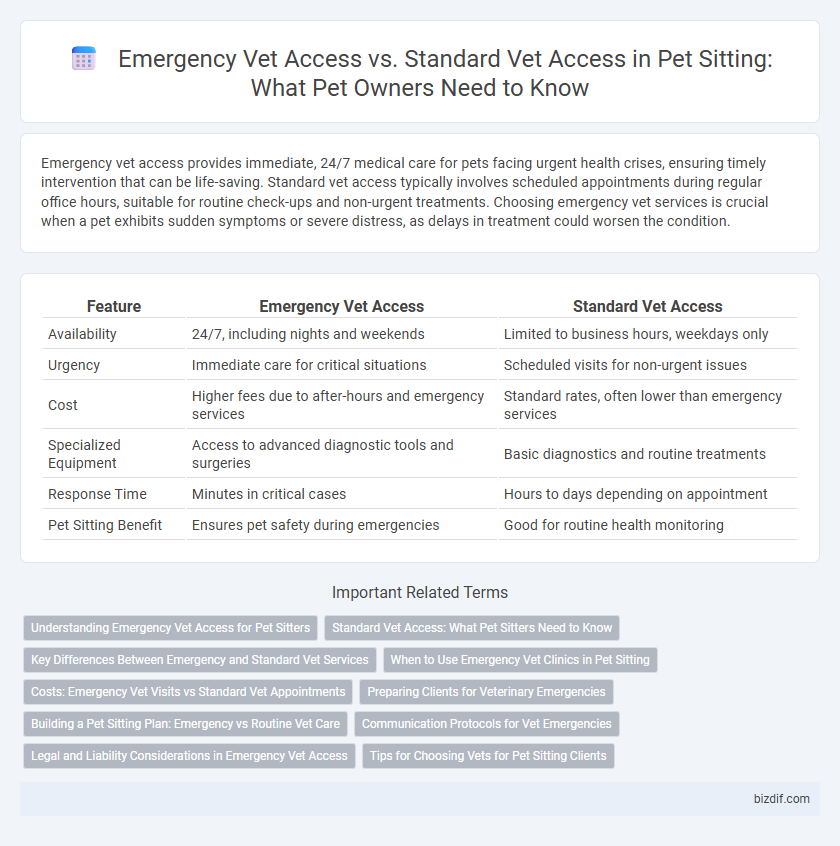Emergency vet access provides immediate, 24/7 medical care for pets facing urgent health crises, ensuring timely intervention that can be life-saving. Standard vet access typically involves scheduled appointments during regular office hours, suitable for routine check-ups and non-urgent treatments. Choosing emergency vet services is crucial when a pet exhibits sudden symptoms or severe distress, as delays in treatment could worsen the condition.
Table of Comparison
| Feature | Emergency Vet Access | Standard Vet Access |
|---|---|---|
| Availability | 24/7, including nights and weekends | Limited to business hours, weekdays only |
| Urgency | Immediate care for critical situations | Scheduled visits for non-urgent issues |
| Cost | Higher fees due to after-hours and emergency services | Standard rates, often lower than emergency services |
| Specialized Equipment | Access to advanced diagnostic tools and surgeries | Basic diagnostics and routine treatments |
| Response Time | Minutes in critical cases | Hours to days depending on appointment |
| Pet Sitting Benefit | Ensures pet safety during emergencies | Good for routine health monitoring |
Understanding Emergency Vet Access for Pet Sitters
Emergency vet access for pet sitters ensures immediate care for pets during critical health incidents, contrasting standard vet access which is suitable for regular check-ups and non-urgent concerns. Pet sitters must recognize signs of emergencies like breathing difficulties, seizures, or severe bleeding and have a direct line to 24/7 emergency veterinary services. Understanding these differences guarantees swift responses, potentially saving pets' lives during urgent situations.
Standard Vet Access: What Pet Sitters Need to Know
Standard vet access is crucial for pet sitters to ensure timely care for routine health issues such as vaccinations, minor injuries, and preventive treatments. Understanding the location, hours, and communication protocols of the nearest veterinary clinic helps pet sitters manage non-urgent medical needs efficiently. Clear guidelines on when to escalate to emergency vet services protect both the pet's health and the sitter's responsibilities.
Key Differences Between Emergency and Standard Vet Services
Emergency vet services provide immediate, 24/7 care for critical and life-threatening conditions such as trauma, poisoning, or severe allergic reactions, unlike standard vet services that typically operate during regular business hours and handle routine check-ups and non-urgent health issues. Emergency vets are equipped with specialized diagnostic tools, surgical facilities, and critical care units designed for rapid intervention, whereas standard vets focus on preventive care, vaccinations, and minor treatments. The response time and availability of emergency vets ensure timely treatment that can significantly improve pet survival rates during urgent health crises.
When to Use Emergency Vet Clinics in Pet Sitting
Emergency vet clinics are essential for pet sitters when pets exhibit signs of severe distress, such as difficulty breathing, uncontrolled bleeding, seizures, or sudden collapse. Standard vet access is suitable for non-urgent issues like vaccinations, minor wounds, or routine check-ups. Recognizing the difference ensures timely intervention, improving pet safety and health during pet sitting.
Costs: Emergency Vet Visits vs Standard Vet Appointments
Emergency vet visits typically cost significantly more than standard vet appointments due to after-hours service fees and urgent care demands. Standard vet visits often include routine check-ups or vaccinations priced between $50 and $150, while emergency visits can range from $200 to over $1,000 depending on the complexity of the treatment. Pet owners should budget for higher expenses during emergencies, as immediate care often involves intensive diagnostics and critical interventions.
Preparing Clients for Veterinary Emergencies
Providing clients with clear guidance on emergency vet access ensures swift action during critical moments, reducing pet health risks and improving outcomes. Standard vet access typically involves scheduled appointments, while emergency services operate 24/7 with immediate care for urgent conditions such as poisoning, trauma, or severe illness. Educating pet owners on recognizing emergency symptoms and having contact information for the nearest emergency clinic prepares them to respond effectively when time-sensitive situations arise.
Building a Pet Sitting Plan: Emergency vs Routine Vet Care
A comprehensive pet sitting plan must prioritize emergency vet access alongside routine care to ensure quick response during critical health events and maintain ongoing wellness. Emergency vet access provides 24/7 availability for life-threatening situations, minimizing delays when immediate intervention is crucial. Routine vet care supports preventive health measures, vaccinations, and regular check-ups, creating a balanced approach that safeguards pets' long-term health while preparing for unforeseen emergencies.
Communication Protocols for Vet Emergencies
Clear communication protocols for emergency vet access involve immediate contact methods, including hotlines or direct lines to emergency clinics, ensuring rapid response in critical situations. Standard vet access communication typically involves scheduled appointments and structured office hours, which may delay urgent care. Establishing predefined emergency contacts and informing pet sitters about specific procedures ensures swift intervention and reduces confusion during vet emergencies.
Legal and Liability Considerations in Emergency Vet Access
Emergency vet access involves immediate medical intervention for pets during urgent health crises, raising specific legal and liability considerations distinct from standard vet visits. Pet sitters must understand consent protocols, as providing or arranging emergency care often requires explicit owner authorization to avoid potential legal disputes. Failure to comply with these requirements can result in liability for unauthorized treatment or negligence, emphasizing the need for clear agreements and communication between pet owners and sitters.
Tips for Choosing Vets for Pet Sitting Clients
Prioritize emergency vet access when selecting vets for pet sitting clients to ensure immediate care during critical situations, especially outside regular hours. Verify the vet's proximity, availability, and 24/7 emergency services alongside standard care options for comprehensive pet health support. Confirm the vet's credentials, specialization in emergency treatment, and communication responsiveness to optimize pet safety and client trust during pet sitting.
Emergency vet access vs standard vet access Infographic

 bizdif.com
bizdif.com